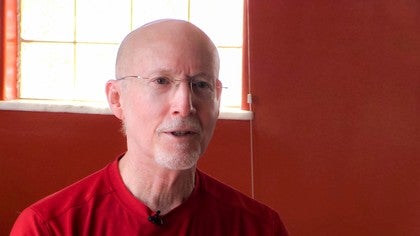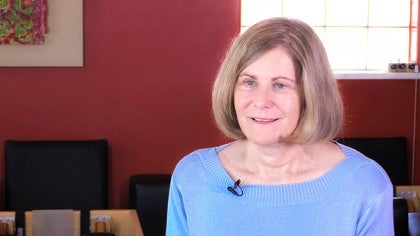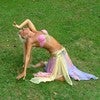Description
About This Video
Transcript
Read Full Transcript
My name is Cora bean. Howard harms. And I first met Eve in 1972 because my folks had moved here to Santa Fe and I had grown up dancing. And, uh, when we arrived in Santa Fe, my folks looked for a dance studio for me and for my sister. We were all doing that. And so we lived on upper Canyon road and, uh, Eva studio was really convenient on Monte Del Sol. And so we signed up and I started that fall in when I was in high school.
And so we did, um, two aspects. We did just modern dance and lots of wonderful creative dance. But then we also started doing the [inaudible] with her. At that time I was 16 and my sister was in fifth grade at that time is when my mother had her first breast cancer and had to have the radical mastectomy and everything. Right then in her early forties. And Eve of course recognized that mother needed help and needed rehabilitation cause they cut out all the muscles here and Eve had had that done.
And so that's where we really got that family connection. And, and you've just swooped in and grabbed my mom was like, I'm going to help you and we're going to help you get back to feeling strong and good and being able to do things. I'm not sure what, how she would have ended up if Eve hadn't swooped her up and said, we can do this and you're going to be okay and you're going to be strong again. And then she went on to be a city counselor and president of the league and blah, blah blah. And my mom was, you know, real grassroots and I think Eve really set that example. I mean here she was wonderful world-class person here in Santa Fe and she took every person so kindly and you know, just people who couldn't move at all and she would just try to help them to feel a little bit better. Oh, this is a program of one of our dance programs from the Montego sold studio in 1973 what's so wonderful about it is how eclectic her music taste was. She was interested in exploring modern music, new things, old things. When you look at the record albums that I have from her, she, um, wanted to get to the authentic music and these, most of these are, you know, people taking microphones out into the Bush or the field or whatever and getting the authentic sounds of um, musicians around the planet. And here, George crumbs at your modern composer Morton Subotnick.
Really I've on guard at the time. So just artistically I learned so much from her that way to be eclectic and try new things and really explore. I did two years of dancing exercise with her in high school and then I went to college for two years and then I came back to Santa Fe and that's when I started studying with her. And I actually taught for her when I was a learning to be a teacher for her. Um, I believe I was 20.
What I mostly did was watch her teach and then she gave me all the study materials that I mentioned before. I can't remember the name of the book, but whatever it was. Um, and then, uh, just like with Shelly, I would gradually help people work with people. And, um, that allowed us to have more than one person at the studio, at T at one, at a certain time, so she would be working with this person or that person. So it was just a gradual, um, learning process. And again, since I had started with her in high school, you know, I had a pretty good idea of all the different plays, um, method and movements. I think I decided to write a paper like she was talking about. I didn't, I didn't take a test. Polonius was, no one had even heard of it. And, um, it wasn't like today at all. I think she'd be completely amazed at the, how it's exploded. I fixed, she would just be so happy. I really do. I really do. She's looking down.
Yeah, she was a very exacting, uh, very, very kind of course, but very exacting, very careful. I, I rarely saw her, you know, be upset or angrier. I mean, maybe a cave once in awhile popped out a little bit, but I'm very patient, you know, and just, um, passionate, you know, about wanting it to be right and wanting to help people, wanting to be artistic, wanting to explore very passionate lady Eve and my mother, Bernie being Hauer, a lady named Melinda pike, uh, who is still around and another my dad remembered a fourth name arose that also worked with them and it was the same kind of thing, um, as the having to make the movie without her clothes on the resistance that they got from the doctors about just trying to help women get a prosthesis, what wig should you were just feeling strong, you know, they, it, they were, you know, humiliated and talked down to and all of that. And so their persistence was really admirable. What they would do is they would go right to the hospital when the lady had just, you know, had just had the surgery and was still in the hospital and kind of get resources for her and make her feel okay about, you know, that life was going to be okay. This shows just the card of the night that what the American cancer society honored all of the, uh, founders of the reach to recovery. And it was in 2006 so I got to give a speech to the dinner about even in mom and all that. So it was really, really neat.
And Melinda was there and the program is still in existence and I think they really set an example for helping women and giving them pride and you know, making them feel pretty and all that, all that stuff. As I recall, and again, this is a long time ago, but what I recall was that, um, there had been a [inaudible] book that came out and it was with the lovely lady with the been like on the side, that book. And I think it was maybe one of the really early Pele's books, but Eve wasn't satisfied that it was easy and therapeutic enough for really patients that we had. It was more like exercise for people who were already okay. And we would get, and this was also the time when we were trying to figure out how we could get insurance to help pay for the therapy, because of course you did have to charge some money to have someone come. But these were people who were really suffering an ill and we were trying very hard to figure out how can we get insurance to help these people come for their therapy.
So she wanted to create something that really had all of her therapeutic ideas in it, not just the exercise, but I mean you can tell when you read this, this is for people who are really hurting and can just barely just do the no circle. Okay. Oh, that's it. You know, and, um, we would get people who had had back surgery or you know, would limp in to the studio really, really hurting with their backs or whatever. So as I recall, that was kind of the motivation there that she wanted to have something to give people as they walked out the door that they could really refer to. And, uh, my sister law, Kathy is the one who did the drawings and we, we really even made her do them. Yeah. And he was like, well, no, the nose isn't quite, you know, Cathy would do it again, you know. But anyway, so, um, as I recall, that was really our motivation for that. And we this, this was the routine that the people did when they walked in the door. And, um, you can tell it's very, very gentle. So you could really see for this what the people would do when they'd come to the studio. And I think probably she check off the ones that she wanted people to emphasize or what have you at the time, uh, if, you know, she really wanted her to do them to do that, but maybe skip that or whatever, you know, she would just sort of adjust her thing for that. And, um, so that's how that book came about.
One thing that was so amazing about Eve was her diagnostic abilities. I mean, they would walk in and she would have the person, um, stand facing back and take a photo and then study the alignments and study where the muscles were bigger or smaller or what have you. And um, she could just pinpoint after watching people move a little bit exactly what to do. And her diagnostic skills were pretty awesome, really good. And that's something I've taken with me that I would watch her do that and just see how people's bodies had, uh, either, you know, gotten way too big on the right side or you know, why they had the hammertoes or why they had this or that. The way PyLadies has helped me with playing piano is that as a pianist you want to stay really relaxed. You can't have tension in the arms or you know, you can't do any weird angle, which is one nice thing about playing piano. I mean, when you think about violin, what an awkward, unnatural position this is to do this eight hours a day.
But for piano, it's, it's pretty straight forward. Um, but you want at play with your natural weight in your hand. You know, like this, you know, it's just natural. And um, all of that came right out of PyLadies for sure. And staying relaxed and your neck and shoulders and, um, how not to get tired. All those things came straight out of that and sitting properly, you know, all of that. And when I get arthritis, I do the little, the little tiny circles, cause I get arthritis now. Yes, absolutely. I do.
Pilates Legacy Project - Playlist 17: Discussions
Comments
Thank you for sharing your experiences with Eve. How would I get a copy of her therapeutic notebook?
m.hales71@gmail.com
Michelle
I'm not sure there are copies really to be had at this point. It seems each of the teachers and students still had theres but it didn't seem they were interested in letting them go given Eve had often written in them. Michele Larsson will be here in May. I'll ask her if she knows how we can get a copy of one.
You need to be a subscriber to post a comment.
Please Log In or Create an Account to start your free trial.










